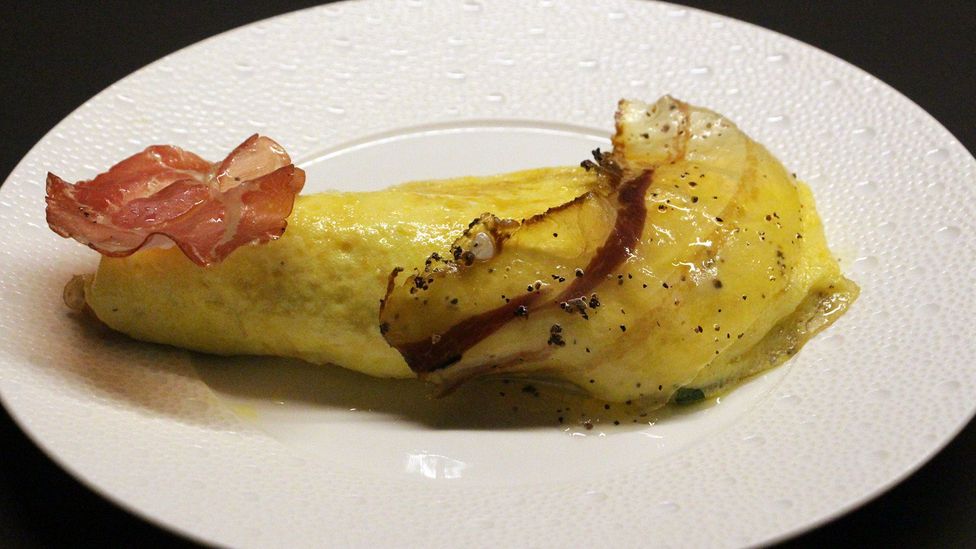Joining a French restaurant kitchen is a baptism by fire. An apprentice has mere moments to make an impression, and, according to Yves Camdeborde, owner of Paris' four Avant-Comptoir restaurants, is frequently given a task whose outward simplicity conceals true technicity. To succeed is to garner favour; to fail is to show one still has much to learn. Such is the role, from corner bistros to Michelin-starred dining rooms, of the omelette.
A French omelette, Camdeborde explained, stands out from versions where fillings are mixed right in with the eggs.
"We make an envelope," he said. "We fill it, and we roll."
The resulting omelette should be pale white outside and baveuse (literally, "drooling") within. And Camdeborde should know.
In a story he has clearly told many times before, he recalled his certificat d'aptitude professionnelle (CAP) vocational qualification. Apprentices' tasks were set at random, he said, and the 16-year-old Camdeborde was assigned omelette aux fines herbes (omelette with herbs).
"I think I got 17 or 18 (out of 20)," he said. "I was top of my CAP class – thanks to the omelette!"
His score earned him a spot in the regional Meilleur Apprenti de France (Best Apprentice in France) competition, among "kids from two- and three-Michelin-starred restaurants".
"I was the only one who came from a little neighbourhood bistro," he said. At this competition too, he was randomly assigned the omelette, earning him a spot at the semi-finals in Paris. Here, the young apprentice made one last omelette and earned the chance to partake in a final challenge.
Alas, the next assignment proved far more onerous. He was tasked with making slow-cooked veal Choisy, with its white wine sauce and braised lettuce accompaniment, and sole soufflée, which sees the delicate fish stuffed with a mushroom cream. He had never even heard of the elaborate dishes, much less made them. Upon finishing ninth of nine, he burst into tears, pulling on the heartstrings of the chef de cuisine.
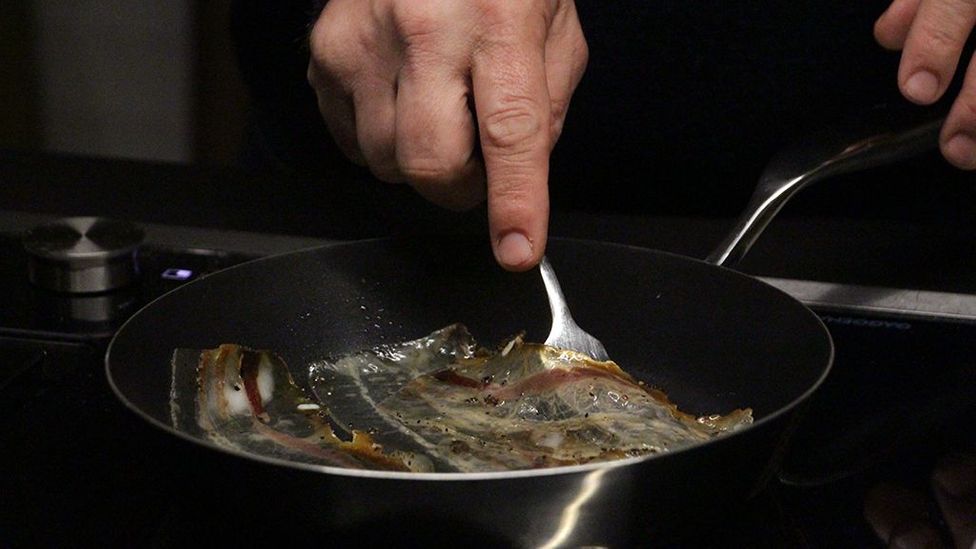
Fried lardo gives the omelette soul (Credit: Emily Monaco)
"He said, 'Listen, it's not a big deal. In life, we're always learning'," recalled Camdeborde. "'If you want, I'll hire you.' He was the chef of the Ritz."
Camdeborde has since cooked at the Michelin-starred Tour d'Argent, revolutionised Parisian dining as a founding father of the bistronomy movement, and judged four seasons of MasterChef France. And it all began with a humble omelette.
Of course, his mastery of the dish was no fluke. At 14, in south-western France, the Pau native had begun his apprenticeship at a local bistro where omelettes were the house specialty.
"We had maybe 30 omelettes on the menu," he said, estimating after some quick maths that he must have "easily" made about 20,000 in his two years there. At that point, "you can do it with your eyes closed."
He begins with fresh eggs – three per person. And eggs, he says, "need fat".
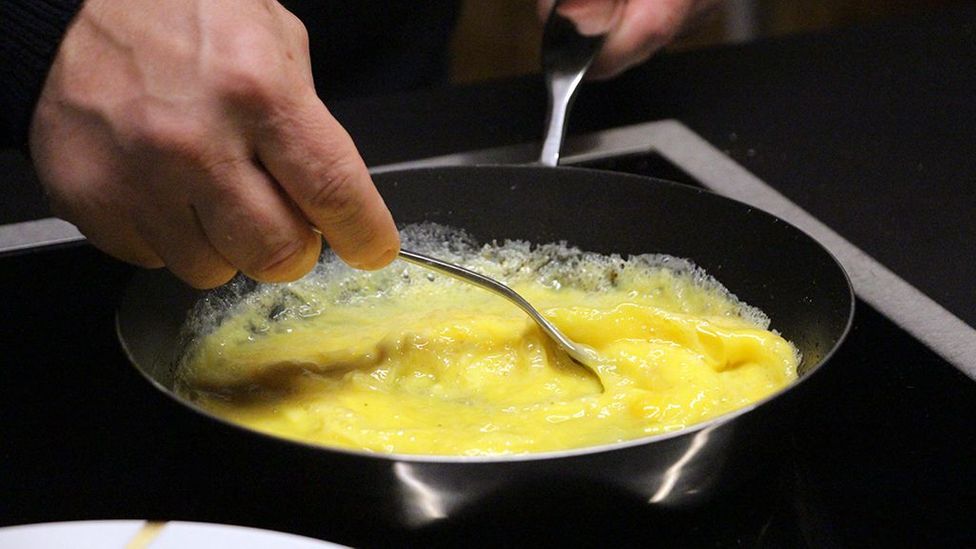
Yves Camdeborde stirs the eggs gently, until they just begin to set (Credit: Emily Monaco)
"For flavour, ideally, you want pork fat," he said, frying lardo and coppa in a drizzle of oil until just translucent. "It gives the dish soul."
Only once the fat is rendered, he cautioned, should the eggs be broken. "Once you crack them," he said, "they liquify and lose their structure."
He whisked the eggs lightly, immediately adding them to the hot fat and stirring gently with a fork until they just began to set.
"When an egg cooks too much, it loses its creaminess," he explained. And so, it was atop still runny eggs that he scattered the filling – in this case, crisp charcuterie and a handful of coriander – before the most technical step: rolling.
Camdeborde's movements were deft and familiar: wielding a fork, he lifted one edge of egg, folding it gently over the filling. A small knob of butter slipped beneath to ease the omelette's release; the ends were nudged inwards, much in the manner of folding a burrito. The fork abandoned, Camdeborde smacked the pan handle with his palm to encourage the omelette's continued trajectory, and, tilting plate and pan, he let gravity do the last of the work: the perfect pale pillow rolled out gracefully onto the plate.
"Once you've mastered it, it doesn't take long," he said, garnishing with the remaining charcuterie.
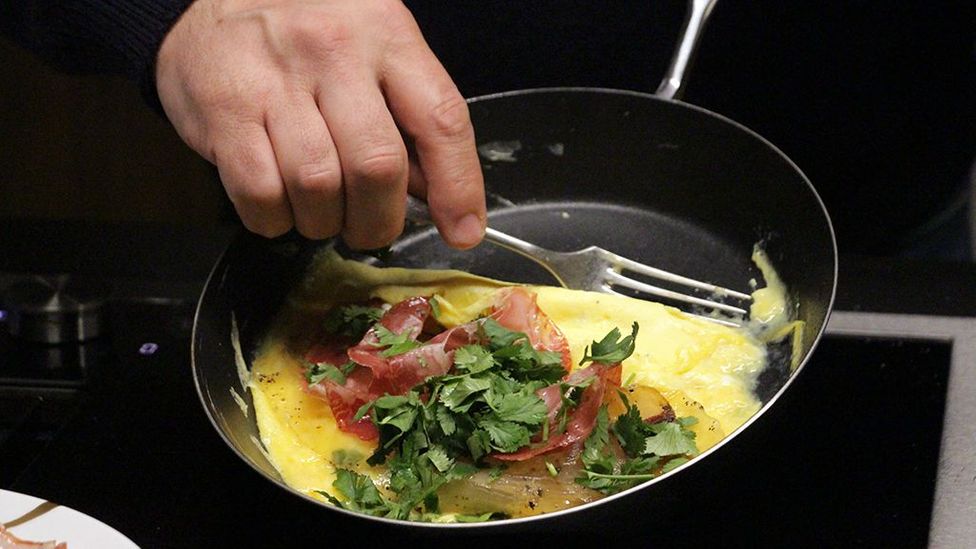
After adding charcuterie and coriander, the omelette is rolled (Credit: Emily Monaco)
Modern Parisian menus are perceptively devoid of omelettes; many chefs, Camdeborde mused, find the dish too "banal". To his mind, however, an omelette is as happy on gingham as linen, as well-accompanied by "caviar as a bit of lard".
But perhaps an omelette is happiest at home: His, after all, are usually destined for his family of four, "often on a Sunday night", in stark contrast to the cross-the-pond penchant for breakfast eggs, a tradition he dubbed "very Anglo-Saxon, like eating blood sausage in the morning".
On his father's farm, Camdeborde enjoyed dinner omelettes "at least once a week. At least". Made with eggs from their own chickens and filled with home-canned peas or tomatoes, these omelettes were drizzled with a touch of Banyuls vinegar – his father's secret sauce.
Such an omelette could easily feed a crowd. Camdeborde recalls his father whisking together as many as 20 eggs; with a big enough pan, it would still cook up in mere minutes.
"There's a festive quality to it," he said with a nostalgic smile. As a teenager, after a night of carousing with rugby friends until the wee hours, "I knew I could wake Dad and say, 'Dad, there's 10 of us… could you make us an omelette?'"
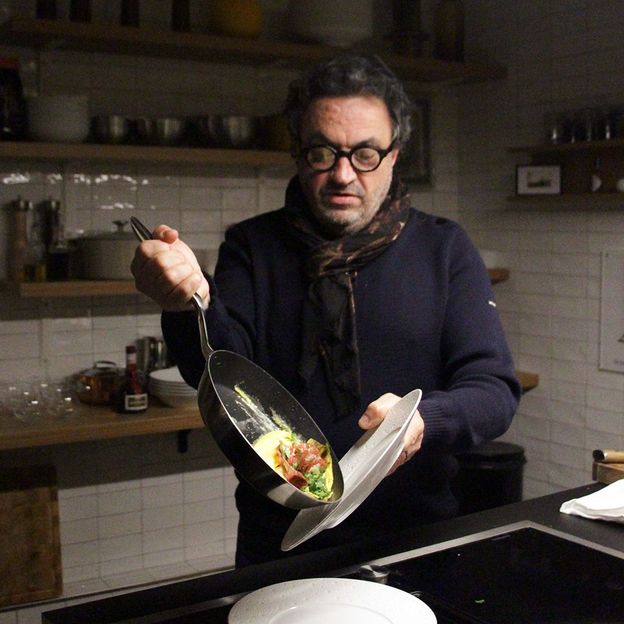
Yves Camdeborde smacks the pan handle to roll the perfect omelette onto the plate (Credit: Emily Monaco)
Ingredients
1 tsp peanut oil
3 thin slices lardo
3 thin slices coppa
3 eggs
salt and pepper, to taste
unsalted butter, to taste
1 small handful chopped coriander
a few drops of Banyuls vinegar (optional)
Method
Step 1
In a non-stick 25cm (10in) frying pan, heat the peanut oil over medium-low heat. Add the lardo to render the fat, about two minutes per side, or until translucent. Remove from the pan and do the same with the coppa. If the meats don't render enough fat, add a touch of butter to the pan.
Step 2
Keep the pan over medium-low heat and crack the eggs into a bowl. Whisk gently with a fork until homogenous. Take care not to over whisk, as you risk losing the creaminess of the eggs. Season with salt and pepper, then pour the eggs into the hot fat. With a fork, make delicate, circular movements to form large curds of egg in the pan. When the yolks just begin to coagulate but the omelette is still quite runny, reduce the heat to low and add two slices of lardo, two of coppa and the coriander. Using a fork, gently fold the edge of the omelette around the filling. After one fold, add a touch of butter to the pan and tilt the pan so that the butter runs under the omelette. Use the fork to fold the edges of the omelette in, like folding the edges of a burrito, and then use the palm of your hand to bang on the pan handle and unstick the omelette.
Step 3
Place the pan's edge over a plate and tilt the plate towards the pan. Finish rolling the omelette directly onto the plate. (It should roll all on its own.)
Step 4
Garnish with the last slices of lardo and coppa, and drizzle, if desired, with a few drops of Banyuls vinegar.
Tip
Butter is a fine stand-in for a vegetarian iteration, provided it's melted over very low heat.
BBC.com's World's Table "smashes the kitchen ceiling" by changing the way the world thinks about food, through the past, present and future.
---
Join more than three million BBC Travel fans by liking us on Facebook, or follow us on Twitter and Instagram.
If you liked this story, sign up for the weekly bbc.com features newsletter called "The Essential List". A handpicked selection of stories from BBC Future, Culture, Worklife and Travel, delivered to your inbox every Friday.
